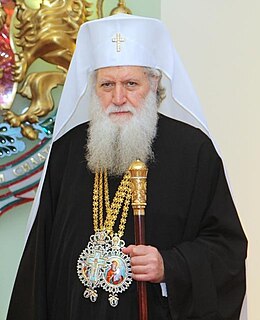
The Eastern Orthodox Church, like the Catholic Church, claims to be the One, Holy, Catholic and Apostolic Church.

The highest-ranking bishops in Eastern Orthodoxy, Oriental Orthodoxy, the Catholic Church, and the Church of the East are termed patriarchs.

The term exarch comes from the Ancient Greek ἔξαρχος, exarchos, and designates holders of various historical offices, some of them being political or military and others being ecclesiastical.

The Bulgarian Exarchate was the official name of the Bulgarian Orthodox Church before its autocephaly was recognized by the Ecumenical See in 1945 and the Bulgarian Patriarchate was restored in 1953.

The Patriarch of All Bulgaria is the Patriarch of the Bulgarian Orthodox Church. The Patriarch is officially styled as Patriarch of All Bulgaria and Metropolitan of Sofia. Patriarch Neophyte acceded to this position on 24 February 2013.

Saint Euthymius of Tarnovo was Patriarch of Bulgaria between 1375 and 1393. Regarded as one of the most important figures of medieval Bulgaria, Euthymius was the last head of the Bulgarian Orthodox Church in the Second Bulgarian Empire. Arguably the best esteemed of all Bulgarian patriarchs, Euthymius was a supporter of hesychasm and an authoritative figure in the Eastern Orthodox world of the time.

Alphabetical list of Eastern Christianity-related articles on English Wikipedia
Philotheos Kokkinos was the Ecumenical Patriarch of Constantinople for three periods from November 1353 to 1354, 1354, and 1364 to 1376. He was appointed patriarch in 1353 by the emperor John VI Kantakouzenos, deposed by John V Palaiologos in 1354 and then restored by Patriarch Callistus I of Constantinople. He was an anti-unionist who opposed Emperor John V in his intent to negotiate re-union of the churches with Popes Urban V and Gregory XI. He is commemorated on October 8.

Gregory V, was Ecumenical Patriarch of Constantinople from 1797 to 1798, from 1806 to 1808 and from 1818 to 1821. He was responsible for much restoration work to the Patriarchal Cathedral of St George, which had been badly damaged by fire in 1738.
The Holy Venerable Theodosius of Tarnovo was a high-ranking 14th-century Bulgarian cleric and hermit and the person credited with establishing hesychasm in the Second Bulgarian Empire. A disciple of Gregory of Sinai, Theodosius founded the Kilifarevo monastery and school near the then-Bulgarian capital Tarnovo and took an important part in the condemning of various heresies during the reign of Tsar Ivan Alexander of Bulgaria.

The history of the Eastern Orthodox Church is traced back to Jesus Christ and the Apostles. The Apostles appointed successors, known as bishops, and they in turn appointed other bishops in a process known as Apostolic succession. Over time, five Patriarchates were established to organize the Christian world, and four of these ancient Patriarchates remain Orthodox today. Orthodox Christianity reached its present form in Late Antiquity, when the Ecumenical Councils were held, doctrinal disputes were resolved, the Fathers of the Church lived and wrote, and Orthodox worship practices settled into their permanent form.
The Archbishop of Ohrid is a historic title given to the primate of the Archbishopric of Ohrid.
The Bulgarian Orthodox Church – Alternative synod is an Eastern Orthodox Church that claimed to be the sole legitimate Orthodox Church in Bulgaria between 1996 and 2015.

In AD 1453, the city of Constantinople, the capital and last stronghold of the Byzantine Empire, fell to the Ottoman Empire. By this time Egypt had been under Muslim control for some seven centuries. Jerusalem had been conquered by the Umayyad Muslims in 638, won back by Rome in 1099 under the First Crusade and then reconquered by Saladin's forces during the Siege of Jerusalem in 1187. It was conquered by the Ottomans in 1517. Orthodoxy, however, was very strong in Russia which had recently acquired an autocephalous status; and thus Moscow called itself the Third Rome, as the cultural heir of Constantinople. Under Ottoman rule, the Greek Orthodox Church acquired power as an autonomous millet. The ecumenical patriarch was the religious and administrative ruler of the entire "Greek Orthodox nation", which encompassed all the Eastern Orthodox subjects of the Empire.
Gregory the Bulgarian, or Gregory II was an Uniate Ruthenian metropolitan in Kiev, then in the Grand Duchy of Lithuania. His official title was "Metropolitan of Kiev, Galich and All Rus'".

Patriarch Neophyte is the current head of the Bulgarian Orthodox Church from 24 February 2013. Prior to his election, he was the Metropolitan of Ruse.
Joachim III was the Patriarch of the Bulgarian Orthodox Church between c. 1282 and 1300, when the Second Bulgarian Empire reached its lowest point of decline during the reign of the emperors George Terter I, Smilets and Chaka. He was executed for treason by emperor Theodore Svetoslav in 1300. The Church did not recognize his guilt and his name was included in the list of Bulgarian Patriarchs in the Book of Boril. His seat was Tarnovo, the capital of Bulgaria.










